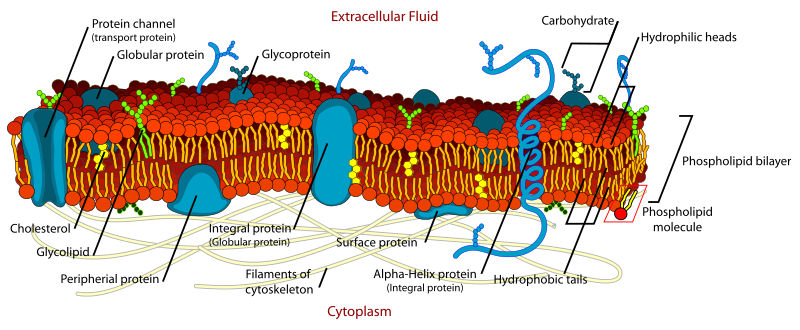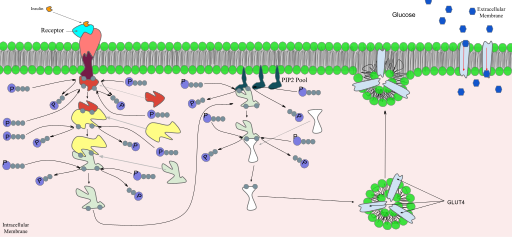OCR Specification focus:
‘Explain membranes as partially permeable barriers, reaction sites and communication sites.’
Cell membranes are dynamic structures essential for maintaining cell integrity, communication, and metabolic control. They regulate movement of substances, enable signalling, and support biochemical reactions vital for life.
Structure and Roles of Cell Membranes
The Nature of Biological Membranes
All biological membranes share a phospholipid bilayer foundation interspersed with proteins, carbohydrates, and cholesterol. This arrangement is described by the fluid mosaic model, which emphasises both fluidity and diversity in structure.

Labeled illustration of the fluid mosaic membrane showing a phospholipid bilayer with embedded proteins, cholesterol, and external glycoproteins/glycolipids. These components underpin selective permeability, cell recognition, and membrane fluidity required for transport and signalling. Some labels (e.g. cytoskeleton attachment) add useful context beyond the minimum syllabus detail. Source.
Fluid Mosaic Model: The concept that membranes are composed of a fluid phospholipid bilayer in which proteins are scattered or embedded, allowing movement and flexibility.
The fluidity of the bilayer permits movement of proteins and lipids within the plane of the membrane, which is crucial for transport and communication. Membranes are partially permeable, allowing selective passage of molecules depending on size, polarity, or charge.
Roles of Cell Membranes
Cell membranes serve several key functions essential to cell survival and coordination:
Partially permeable barrier: Controls entry and exit of substances to maintain homeostasis.
Compartmentalisation: Isolates organelles, allowing specific metabolic reactions to occur efficiently.
Reaction sites: Provides surfaces where enzymes and substrates can interact.
Cell recognition and signalling: Enables communication through surface molecules and receptor sites.
Transport facilitation: Allows passive and active movement of materials.
Each role contributes to overall cell regulation, ensuring that biochemical activities are coordinated and appropriately localised.
The Plasma (Cell Surface) Membrane
Selective Permeability
The plasma membrane separates the internal cytoplasm from the external environment. Its selective permeability allows:
Small non-polar molecules (e.g. oxygen, carbon dioxide) to diffuse directly through.
Larger or charged molecules to move via transport proteins.
Selective Permeability: The ability of a membrane to control which substances pass through, typically allowing small, non-polar molecules but restricting ions and polar compounds.
This regulation maintains stable internal conditions, known as cellular homeostasis, despite changing external environments.
Membrane Proteins and Their Roles
Membrane proteins perform vital structural and functional roles:
Channel proteins: Provide hydrophilic pores for ions and water-soluble molecules.
Carrier proteins: Bind and transport specific molecules by changing shape.
Receptor proteins: Detect and respond to chemical signals such as hormones.
Glycoproteins and glycolipids: Aid in cell recognition and immune responses.
Proteins are embedded or attached to the bilayer, ensuring diverse interactions between the cell and its surroundings.
Intracellular Membranes and Compartmentalisation
Within eukaryotic cells, internal membranes form organelles such as mitochondria, chloroplasts, the endoplasmic reticulum, and Golgi apparatus. These membranes:
Provide distinct environments for specialised processes (e.g. respiration, photosynthesis).
Increase efficiency by grouping related enzymes and substrates.
Facilitate transport of materials between compartments.
Compartmentalisation: The division of the cell’s interior into membrane-bound regions to allow specific biochemical reactions to occur under optimal conditions.
By maintaining unique conditions (pH, ion concentration), membranes ensure precision in metabolic control.
Membranes as Sites of Chemical Reactions
Membranes are not inert boundaries but active reaction surfaces. Enzymes are often bound to membranes, forming organised complexes that optimise reaction rates. Examples include:
Cristae membranes in mitochondria housing enzymes for ATP synthesis.
Thylakoid membranes in chloroplasts containing photosynthetic pigments.
Rough endoplasmic reticulum membranes facilitating protein synthesis and transport.
The spatial organisation of enzymes along membranes minimises diffusion distances and supports metabolic efficiency.
Cell Signalling and Communication
Overview of Cell Signalling
Cell signalling allows cells to detect and respond to environmental or internal cues, coordinating activity across tissues and organs. This process depends heavily on membrane-associated molecules and receptors.
Cell Signalling: The process by which cells communicate with one another through chemical messengers that bind to specific receptors, triggering a cellular response.
Communication may occur over short or long distances, depending on the signalling molecule and the system involved.
Types of Cell Communication
Paracrine signalling: Between nearby cells using local mediators such as growth factors.
Endocrine signalling: Over long distances via hormones transported in the bloodstream.
Autocrine signalling: When cells respond to signals they themselves release.
Synaptic signalling: Involves neurotransmitters across synapses in the nervous system.
Each mechanism depends on precise receptor-ligand interactions on cell membranes.
Receptors and Signal Transduction
Receptors are specific membrane proteins that recognise and bind signalling molecules such as hormones, neurotransmitters, or drugs.

Diagram of insulin binding to its receptor in the plasma membrane, initiating a phosphorylation cascade that mobilises GLUT4 vesicles to the membrane and increases glucose uptake. This illustrates ligand–receptor binding, signal transduction, and a specific cellular response. The figure includes extra pathway detail (e.g. PIP2 references) that goes beyond the minimal syllabus but remains instructive. Source.
When a signalling molecule (ligand) binds to its receptor:
The receptor changes shape.
This triggers an intracellular cascade of events — known as signal transduction.
Secondary messengers (e.g. cyclic AMP) amplify and transmit the signal within the cell.
A specific cellular response follows, such as gene expression or enzyme activation.
Ligand: A molecule that binds specifically to a receptor to initiate a biological response.
This mechanism ensures that cells respond selectively to relevant stimuli, maintaining control over physiological processes.
Examples of Membrane-Based Signalling
Insulin binding to receptors on liver or muscle cells triggers glucose uptake.
Neurotransmitters such as acetylcholine bind to receptors on post-synaptic membranes to transmit nerve impulses.
Hormones like adrenaline interact with membrane receptors to activate enzyme cascades.
Through these interactions, membranes act as vital communication platforms linking extracellular signals to intracellular effects.
Integration of Membrane Functions
Membranes’ roles as barriers, reaction surfaces, and communication hubs are tightly integrated. For instance:
A receptor-mediated signal may alter membrane transport activity.
Enzyme activity on membranes can generate signalling molecules.
Membrane fluidity ensures that receptors and transporters can rearrange as needed.
Thus, biological membranes are central to maintaining order, coordination, and responsiveness within and between cells.
FAQ
Cholesterol molecules sit between phospholipids in the bilayer, preventing them from packing too closely in cold conditions and restricting their movement when warm.
At low temperatures, cholesterol increases fluidity by preventing phospholipids from becoming too rigid.
At high temperatures, it decreases fluidity by limiting excessive movement of fatty acid tails.
This dual effect stabilises the membrane, ensuring consistent permeability and protein function across temperature changes.
“Partially permeable” reflects that membranes allow only certain substances to cross while others are restricted, based on size, charge, and polarity.
However, permeability isn’t perfectly selective — some small uncharged molecules can diffuse freely, while ions and large polar molecules require transport proteins.
The term emphasises biological variability, recognising that permeability can change in response to cell type, environment, or membrane protein activity.
Loss of fluidity disrupts the mobility and proper function of embedded proteins.
Receptor proteins may fail to move into position for ligand binding.
Transport proteins might lose flexibility, preventing conformational changes needed for molecule passage.
Enzymes anchored in membranes can become inactive if their orientation shifts.
Ultimately, decreased fluidity compromises transport, signalling, and enzyme activity, potentially leading to cell dysfunction or death.
Specificity in signalling relies on molecular complementarity — only ligands with the correct shape and charge fit their receptors.
Additionally:
Each receptor triggers a unique intracellular pathway, preventing overlap.
Signal duration is controlled by enzyme breakdown of the ligand or receptor internalisation after activation.
Spatial separation of receptors in membrane microdomains minimises cross-talk.
These mechanisms ensure precise and coordinated cellular communication despite receptor diversity.
The cytoskeleton supports and organises membrane proteins, ensuring accurate receptor positioning and movement during signalling.
Actin filaments anchor receptors and stabilise microdomains like lipid rafts.
During signal transduction, cytoskeletal components can rearrange, helping to transport signalling complexes to target regions in the cell.
This interplay allows signals received at the membrane to be efficiently relayed to the nucleus or other organelles, linking structural support with communication.
Practice Questions
Question 1 (2 marks)
Describe two roles of the cell surface membrane in eukaryotic cells.
Mark Scheme:
Award one mark for each correct role, up to a maximum of two marks:
Acts as a partially permeable barrier controlling entry and exit of substances. (1)
Provides sites for cell communication or signalling through membrane-bound receptors. (1)
Allows compartmentalisation of reactions and maintenance of different conditions within the cell. (1)
Provides attachment sites for enzymes or cytoskeletal structures. (1)
(Max 2 marks)
Question 2 (5 marks)
Explain how the structure of the cell surface membrane enables it to carry out its functions as a partially permeable barrier and in cell signalling.
Mark Scheme:
Award marks for the following relevant points, up to a maximum of five:
The phospholipid bilayer forms the basic structure of the membrane, creating a hydrophobic interior that prevents passage of water-soluble substances. (1)
Small non-polar molecules such as oxygen and carbon dioxide can diffuse through the bilayer. (1)
Proteins embedded in the bilayer act as channel or carrier proteins, allowing the selective transport of ions or polar molecules. (1)
Glycoproteins and glycolipids on the outer surface act as receptors for hormones or signalling molecules. (1)
When a ligand binds to a receptor, it triggers a conformational change leading to signal transduction and a cellular response. (1)
Cholesterol helps regulate membrane fluidity, maintaining effective function of transport and receptor proteins. (1)
(Max 5 marks)

